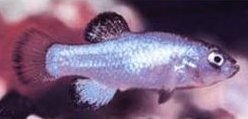Today was a great day for trainees in comparative physiology! Here are some of the highlights from their sessions:
Poster presentations:
Alexis MacDonald et al., (Union College - Mentor Dr. Scott Kirkton) presented research showing that grasshopper skeletal muscles may use lactate for energy!
Similarly, Dongying Wang et al., (Saint Louis University - Mentor Dr. Daniel Warren) also showed that skeletal muscle from painted turtles may use lactate.
I guess it is not just a waste product of exercise after all...
Oral Presentations:
 Image of pupfish by Nevada Fish & Wildlife Office - Public Domain, https://commons.wikimedia.org/w/index.php?curid=1402442
Image of pupfish by Nevada Fish & Wildlife Office - Public Domain, https://commons.wikimedia.org/w/index.php?curid=1402442
Austin McKenna et al., from the University of Nevada Las Vegas spoke about pupfish. What I found fascinating is that these fish actually live in Death Valley where the water temperature can reach more than 33 degrees C. Death Valley was not always as desolate as it is today. About 10,000 years ago there was a lake that ancestors of these fish inhabited. This project was interested in studying how the expression of heat responsive and other proteins varied in fish exposed to environmentally relevant temperatures (33degC) or a relatively cooler temperature of 28degC.
 Bullfrog image by CC BY-SA 2.5, https://commons.wikimedia.org/w/index.php?curid=1079191
Bullfrog image by CC BY-SA 2.5, https://commons.wikimedia.org/w/index.php?curid=1079191
Ivan Evanger et al., University of Alaska presented research on how certain neurons can sense oxygen concentrations and thus help regulate sympathetic nervous system responses in response to hypoxia. The research was conducted in larval bullfrogs that may experience hypoxic conditions in aquatic environments in the wild.
Michael Tift et al., Scripps Institute of Oceanography, presented findings demonstrating that some marine mammals have high levels of carbon monoxide in their blood as a result of high turnover of red blood cells.
Finally, the winner of the Phantastic Physiology Voyage was announced.....*drumroll*.....
- Log in to post comments

